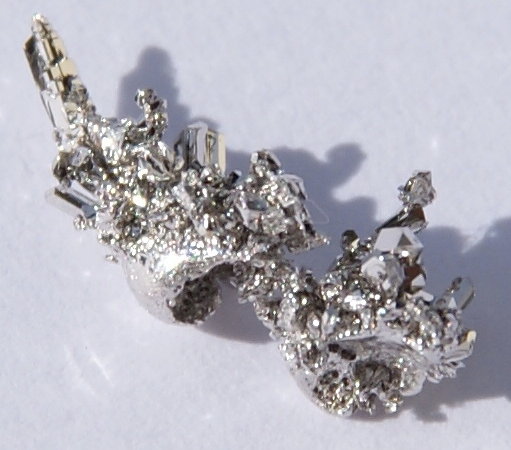Palladium

Palladium
Image by Jurii - source Wikpedia - released under CC 3.0
Palladium - overview
Palladium is one of the six "Noble Metals". Discovered in 1803, it is a scarce silver-white metal belonging to the platinum group. Palladium's unique properties account for its use in a wide range of industrial processes and manufactured goods - and though it is considered a precious metal, industrial uses make up the majority of its demand. [1]
Palladium has the lowest melting point and the lowest density of the platinum group metals. Palladium does not tarnish at room temperature, but when heated to 800ºC its surface will oxidize. One of its most interesting and unusual properties is its ability to absorb hydrogen - it can absorb 900 times its own volume of hydrogen at room temperature. This has led to its use in nuclear fusion technology and research.[1]
Palladium Resources and Production
Palladium, though scarce, is not as rare or expensive as platinum - around a quarter the price. However, there are a limited number of deposits and palladium demand is considered to be greater than supply. Palladium is often found in nature alloyed with other platinum group metals.
Russia is the world's top producer of palladium, and produced 44% of the world's supply (87,000kg) in 2010. Coming in a close second is South Africa with 37% (73,000kg). Other than this, the countries with the most significant palladium mine production in 2010 were the USA (5.9%), Canada (4.8%) and Zimbabwe (3.35%). South Africa is said to hold the greatest palladium reserves. [2]
[1] An significant amount of palladium is derived from the recycling of automobile exhaust catalytic converters - with around 36,400 kg recovered globally in 2008 and 26,000 kg recovered in 2010. [2] [3]
Demand for palladium seems likely to stay - and quite possibly to grow. However in general, increases in prices of raw materials tend to lead to increased research into more cost-effective technologies. On the supply side - with so much of the world's palladium supply coming from so few sources, the greatest possible factor affecting palladium price could be any interruption to the supply chain. As was seen in 2001; interruption to Russian supply caused panic buying and price spiralled to over $1000 / ounce. Palladium price is also influenced by platinum price - if the price of platinum goes high, it can mean that there is greater incentive to use palladium.
Palladium Uses
Palladium has a wide range of industrial uses. Its most famous use is as an element in automobile catalytic converters - and these make up 47% of its demand. [2] Therefore it is expected that palladium price will be greatly influenced by movement in the automotive industry.
Palladium has a number of uses in electronics - including ceramic capacitors which are widely used. [2] It is also a good conductor of electricity - making it a useful alternative to gold in the plating of electrical contacts. Although the amount of palladium used in any given device is likely to be tiny, the sheer number of palladium-containing components manufactured leads to significant demand. [3]
Of the 249,000 kg of palladium sold in 2008, use in automobile catalysts was 136,000 kg. The electronics industry used around 41,200 kg. Around 26,600 kg was used by the jewelry industry. 19,600 kg was used by dentistry for use in fillings. 10,900 kg was used in industrial chemical processing; palladium is used as a catalyst in the manufacture of many chemicals. 12,400 kg was used for investment products (such as bullion bars and palladium coins). [2]
Further / specific uses of palladium include as an alloy in white gold jewelry, in polyester manufacture, in archival quality photographic printing, in water treatment and hydrogen purification. [4]
Palladium is used by the hydrogen industry. When paladium is heated, hydrogen can pass through it and be purified. Palladium chloride is also used in carbon monoxide detectors. [1]
An interesting and unusual development for palladium is that as of July 2009, palladium jewellery sold in the UK must be hallmarked. Palladium is only the fourth metal to require such hallmarking - the others being gold, silver and platinum. This indicates new prospects for palladium within the world of jewelry and a possible increase in demand. [5]
Palladium Facts
| Name | Palladium |
| Symbol | Pd |
| Atomic Number | 46 |
| Melting point (Celsius) | 1554.9ºC |
| Density | 12.023 g/cc |
| Hardness (Moh) | 4.75 |
| Resistivity (nanoOhms / meter at 20ºCelsius) | 105.4 |
Palladium References:
[1] http://en.wikipedia.org/wiki/Palladium
[2] http://minerals.usgs.gov/minerals/pubs/commodity/platinum/mcs-2011-plati.pdf
[3] http://minerals.usgs.gov/minerals/pubs/commodity/platinum/myb1-2008-plati.pdf
[4] http://www.stillwaterpalladium.com/uses.html
[5] "Platinum Metals Review" 2010 no.1 - http://www.platinummetalsreview.com

This website is not investment advice or a recommendation to buy or sell.


